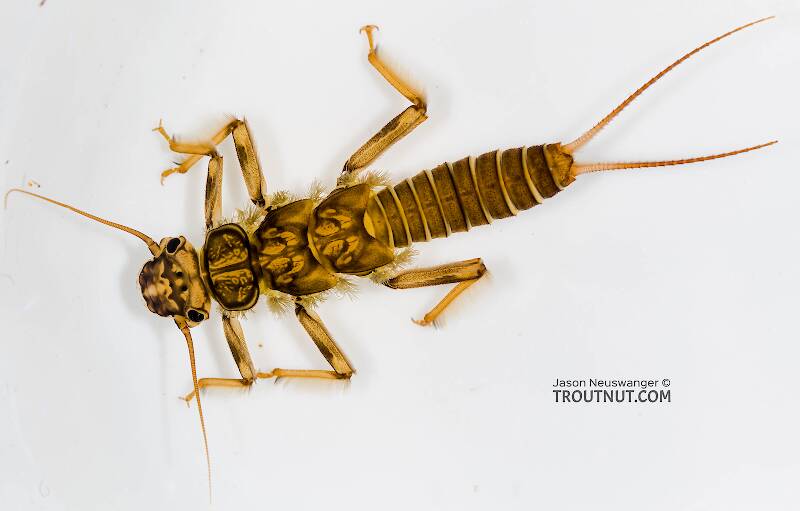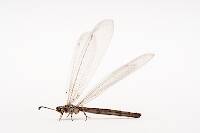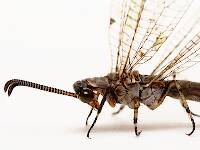
Salmonflies
Pteronarcys californica
The giant Salmonflies of the Western mountains are legendary for their proclivity to elicit consistent dry-fly action and ferocious strikes.
Featured on the forum

Troutnut is a project started in 2003 by salmonid ecologist Jason "Troutnut" Neuswanger to help anglers and
fly tyers unabashedly embrace the entomological side of the sport. Learn more about Troutnut or
support the project for an enhanced experience here.
Softhackle on Dec 21, 2011December 21st, 2011, 7:23 am EST
Friends,
Thought I'd share some perfection with you. A good friend sent me this little treasure, and while it's not the best photo, it still shows the perfection and beauty of a well tied Catskill Dry Fly by Mary Dette. She was part of the famous Dette fly tying business which included her dad, Walt, her mom Winnie and herself. Mary still ties flies, albeit, to special customers only. What a treasure!

Mark
Thought I'd share some perfection with you. A good friend sent me this little treasure, and while it's not the best photo, it still shows the perfection and beauty of a well tied Catskill Dry Fly by Mary Dette. She was part of the famous Dette fly tying business which included her dad, Walt, her mom Winnie and herself. Mary still ties flies, albeit, to special customers only. What a treasure!

Mark
"I have the highest respect for the skilled wet-fly fisherman, as he has mastered an art of very great difficulty." Edward R. Hewitt
Flymphs, Soft-hackles and Spiders: http://www.troutnut.com/libstudio/FS&S/index.html
Flymphs, Soft-hackles and Spiders: http://www.troutnut.com/libstudio/FS&S/index.html
Oldredbarn on Dec 21, 2011December 21st, 2011, 7:42 am EST
Very nice Mark! There's a gem for your collection.
http://www.danica.com/flytier/wwdette/wwdette.htm
I know you know this already Mark, but for others, here's a link to a dozen by Walt & Winnie that belong to Steve Williams. Steve, though from the Carolinas, has fished the Au Sable here in Michigan for decades. The story he has there of how he obtained the flies is interesting. After checking them out there are some of Mary's flies on Hans' web page just below yours mister...:)
Oh! There are some of Steve's flies too.
Spence
http://www.danica.com/flytier/wwdette/wwdette.htm
I know you know this already Mark, but for others, here's a link to a dozen by Walt & Winnie that belong to Steve Williams. Steve, though from the Carolinas, has fished the Au Sable here in Michigan for decades. The story he has there of how he obtained the flies is interesting. After checking them out there are some of Mary's flies on Hans' web page just below yours mister...:)
Oh! There are some of Steve's flies too.
Spence
"Even when my best efforts fail it's a satisfying challenge, and that, after all, is the essence of fly fishing." -Chauncy Lively
"Envy not the man who lives beside the river, but the man the river flows through." Joseph T Heywood
"Envy not the man who lives beside the river, but the man the river flows through." Joseph T Heywood
Wbranch on Dec 21, 2011December 21st, 2011, 4:26 pm EST
Is this a Borcher? Or perhaps a Dark Cahill?
Catskill fly fisher for fifty-five years.
Softhackle on Dec 21, 2011December 21st, 2011, 4:57 pm EST
It looks to me like a dark cahill.
Mark
Mark
"I have the highest respect for the skilled wet-fly fisherman, as he has mastered an art of very great difficulty." Edward R. Hewitt
Flymphs, Soft-hackles and Spiders: http://www.troutnut.com/libstudio/FS&S/index.html
Flymphs, Soft-hackles and Spiders: http://www.troutnut.com/libstudio/FS&S/index.html
TNEAL on Dec 21, 2011December 21st, 2011, 6:08 pm EST
It is not a Borchers Special.... that fly was originated in Northern Michigan (Grayling) by Ernie Borchers... Charlie Kroll, Fred Bear's son-in-law, told me that the Borchers was , hands down, the most effective dry fly he'd ever fished.... and, according to him, he had fished "most of the good trout streams around the world".
Entoman on Dec 21, 2011December 21st, 2011, 8:02 pm EST
Beautiful fly, Mark. Looks like a Gray Fox variation to me. I'm seeing a mix of grizzly and ginger hackle. Can't quite make out the body and tail color, but it looks like ginger or dun tail and either beaver belly or fox dubbing.
"It's not that I find fishing so important, it's just that I find all other endeavors of Man equally unimportant... And not nearly as much fun!" Robert Traver, Anatomy of a Fisherman
Softhackle on Dec 22, 2011December 22nd, 2011, 3:05 am EST
I may be able to get it identified, I'll see.
Mark
Mark
"I have the highest respect for the skilled wet-fly fisherman, as he has mastered an art of very great difficulty." Edward R. Hewitt
Flymphs, Soft-hackles and Spiders: http://www.troutnut.com/libstudio/FS&S/index.html
Flymphs, Soft-hackles and Spiders: http://www.troutnut.com/libstudio/FS&S/index.html
Oldredbarn on Dec 22, 2011December 22nd, 2011, 5:12 am EST
The thing I find interesting about the way they "finished" their flies is how far back from the eye they ended up. If you look at Mary's flies on Hans' web page or in the book of Leiser's called "The Dettes" you will see what I'm talking about. Leiser speaks to it in his book. I have always finished a bit closer to the eye and my head wraps close off that little gap there on the hook eye.
No one wraps hackle as consistantly as they did...The proportions are right-on in terms of the dry fly. If you were to look up one of those little drawings in beginning tying books and look at the one for dries that show proper length of wing, tail, hackle, and body length you could hold it up to your fly there Mark and it would be dead on!
How many flies did those three put out in their careers?! Wow!
Spence
There is a great photo in that book of Leiser's on the Dettes that is called "The Last Summit" and shows Watt & Winnie, Harry Darbee, and Art Flick...Man! Wouldn't it have been great to have been a fly on that wall!?
No one wraps hackle as consistantly as they did...The proportions are right-on in terms of the dry fly. If you were to look up one of those little drawings in beginning tying books and look at the one for dries that show proper length of wing, tail, hackle, and body length you could hold it up to your fly there Mark and it would be dead on!
How many flies did those three put out in their careers?! Wow!
Spence
There is a great photo in that book of Leiser's on the Dettes that is called "The Last Summit" and shows Watt & Winnie, Harry Darbee, and Art Flick...Man! Wouldn't it have been great to have been a fly on that wall!?
"Even when my best efforts fail it's a satisfying challenge, and that, after all, is the essence of fly fishing." -Chauncy Lively
"Envy not the man who lives beside the river, but the man the river flows through." Joseph T Heywood
"Envy not the man who lives beside the river, but the man the river flows through." Joseph T Heywood
Softhackle on Dec 22, 2011December 22nd, 2011, 5:56 am EST
HI all,
It's a March Brown.
Spence,
proportions are very important to this style fly. Mary fly is superb. Everything is exact, and the more I look at it the more amazed I am by it. The Dettes along wwith the other famous tying team, the Darbees, were very prolific and supplied the world with tons of these flies.
I visited Walt Dette many years ago. Winnie and Mary must have been out shopping. I was amazed at the scores of hackle necks and materials, there. Walt tied a couple flies in the short time I visited.
I think the space at the hook eye had something to do with leaving a bit of room for the gut leaders they use to use, and it became an integral part of the Catskill design.
Mark
It's a March Brown.
Spence,
proportions are very important to this style fly. Mary fly is superb. Everything is exact, and the more I look at it the more amazed I am by it. The Dettes along wwith the other famous tying team, the Darbees, were very prolific and supplied the world with tons of these flies.
I visited Walt Dette many years ago. Winnie and Mary must have been out shopping. I was amazed at the scores of hackle necks and materials, there. Walt tied a couple flies in the short time I visited.
I think the space at the hook eye had something to do with leaving a bit of room for the gut leaders they use to use, and it became an integral part of the Catskill design.
Mark
"I have the highest respect for the skilled wet-fly fisherman, as he has mastered an art of very great difficulty." Edward R. Hewitt
Flymphs, Soft-hackles and Spiders: http://www.troutnut.com/libstudio/FS&S/index.html
Flymphs, Soft-hackles and Spiders: http://www.troutnut.com/libstudio/FS&S/index.html
Entoman on Dec 22, 2011December 22nd, 2011, 8:38 am EST
Spence - If you look closely at the eye, that isn't a stub of material at the apex but rather a purposeful layer of thread. I assume it was laid down at the start of the fly to close the eye. I think you have the reason right for the 'two step" head, Matt. The old Catskill boys loved the Turle knot (an affinity I share) and an eye finished off in this manner would lock it in perfectly. There is another reason though, and that is this method also allows for a small head without the wings and hackle finishing too close. This makes the fly more resistant to falling over on its head. On a related point, one of the few things lamentable in modern hook designs is that the down-turned eyes are less aggressive in adaption to angler affinity for knots that finish in front of the eye. Older models allowed for the Turle to finish with the tippet in perfect alignment with the shank.
I've noticed before that the Dette's proportions are almost a semi-variant. This takes an incredible amount of skill in wing placement as wings this much longer than the shank have a tendency to tip the fly over to one side or the other unless mounted perfectly.
I've noticed before that the Dette's proportions are almost a semi-variant. This takes an incredible amount of skill in wing placement as wings this much longer than the shank have a tendency to tip the fly over to one side or the other unless mounted perfectly.
"It's not that I find fishing so important, it's just that I find all other endeavors of Man equally unimportant... And not nearly as much fun!" Robert Traver, Anatomy of a Fisherman
Oldredbarn on Dec 22, 2011December 22nd, 2011, 8:52 am EST
Kurt,
That makes perfect sense.
In the "Dette" book they explain that when they are wrapping two hackles they don't snip the excess until the second feather has been wrapped and the whip finish is complete. They trim it after...Must be a commercial tyer trick...They don't use bobbins, they don't dub onto the thread but do a variation of the noodle, and they use small hemostats instead of hackle pliers... They claim the hemo's work better in controlling non-cooperative feathers during the wrapping...Maybe we could all send an order in to Tony for small fly tying hemo's for Christmas...:)
Spence
You can learn some great short-cuts by just sitting and watching a real commercial tyer tie...Tim Neal's buddy from Grayling, Jerry Regan, I have watched a thousand times as he ties his Brown Drake hackle tip spinner and he does this thing with the wings that looks so right when he does it, and a nightmare when I try it...:) He has only done it a trillion times!
I like going to tying shows and just sitting and watching the better tyers and seeing their tricks and the materials they use...Earlier this month at an FFF tying expo I sat with Oscar Feliu and watched him tie Hex duns, upside down,on Mustad 37160's...The bug looked killer!
That makes perfect sense.
In the "Dette" book they explain that when they are wrapping two hackles they don't snip the excess until the second feather has been wrapped and the whip finish is complete. They trim it after...Must be a commercial tyer trick...They don't use bobbins, they don't dub onto the thread but do a variation of the noodle, and they use small hemostats instead of hackle pliers... They claim the hemo's work better in controlling non-cooperative feathers during the wrapping...Maybe we could all send an order in to Tony for small fly tying hemo's for Christmas...:)
Spence
You can learn some great short-cuts by just sitting and watching a real commercial tyer tie...Tim Neal's buddy from Grayling, Jerry Regan, I have watched a thousand times as he ties his Brown Drake hackle tip spinner and he does this thing with the wings that looks so right when he does it, and a nightmare when I try it...:) He has only done it a trillion times!
I like going to tying shows and just sitting and watching the better tyers and seeing their tricks and the materials they use...Earlier this month at an FFF tying expo I sat with Oscar Feliu and watched him tie Hex duns, upside down,on Mustad 37160's...The bug looked killer!
"Even when my best efforts fail it's a satisfying challenge, and that, after all, is the essence of fly fishing." -Chauncy Lively
"Envy not the man who lives beside the river, but the man the river flows through." Joseph T Heywood
"Envy not the man who lives beside the river, but the man the river flows through." Joseph T Heywood
TNEAL on Dec 22, 2011December 22nd, 2011, 10:34 am EST
Oscar is a great tyer... he spent considerable time in my neck of the woods (Grayling, MI) years ago. He was good then; no doubt is much better now.
Wbranch on Dec 22, 2011December 22nd, 2011, 10:41 am EST
Kurt wrote;
"I've noticed before that the Dette's proportions are almost a semi-variant."
I didn't want to say it but I don't think this fly has the "ideal" hackle length as prescribed in many of the older fly tying books. I always read the hackle barbule length was to be one to one and a half times the hook gape. This hackle is easily two times the hook gape, more like a variant than a traditional, classic, Catskill dry fly.
That's my $.02 and I'm sticking to it.
"I've noticed before that the Dette's proportions are almost a semi-variant."
I didn't want to say it but I don't think this fly has the "ideal" hackle length as prescribed in many of the older fly tying books. I always read the hackle barbule length was to be one to one and a half times the hook gape. This hackle is easily two times the hook gape, more like a variant than a traditional, classic, Catskill dry fly.
That's my $.02 and I'm sticking to it.
Catskill fly fisher for fifty-five years.
Oldredbarn on Dec 22, 2011December 22nd, 2011, 11:46 am EST
http://www.danica.com/flytier/mdette/march_brown.htm
Here is Mary Dette's web page on Hans Weilenmann's web page...That seems to be the way she ties them Matt (?)...Other than the Adams and the Borcher's I seldom tie Catskill style flies these days or upright wing/wrapped hackle style flies...
I think there is supposed to be a line one can draw from the tip of the hackle on the bottom to the tip of the tail and the bottom of the hook bend should just rest along that line.
I think you are correct about 1.5 times hook gap for hackle length...
Spence
Here is Mary Dette's web page on Hans Weilenmann's web page...That seems to be the way she ties them Matt (?)...Other than the Adams and the Borcher's I seldom tie Catskill style flies these days or upright wing/wrapped hackle style flies...
I think there is supposed to be a line one can draw from the tip of the hackle on the bottom to the tip of the tail and the bottom of the hook bend should just rest along that line.
I think you are correct about 1.5 times hook gap for hackle length...
Spence
"Even when my best efforts fail it's a satisfying challenge, and that, after all, is the essence of fly fishing." -Chauncy Lively
"Envy not the man who lives beside the river, but the man the river flows through." Joseph T Heywood
"Envy not the man who lives beside the river, but the man the river flows through." Joseph T Heywood
Wbranch on Dec 22, 2011December 22nd, 2011, 3:32 pm EST
I rarely tie "Catskill style" flies any more even though my cabin is in the western Catskills and I'm a few miles west from the "birthplace of American dry fly fishing". Don't know who I'm quoting but have seen the phrase a zillion times in print.
I'd say 80% of the flies I now tie are thorax style with CDC upright wings, maybe 10% are tied somewhat down wing to imitate the emerger, and the rest are some parachutes and a few "Catskill style" just for old times sake.
I'd say 80% of the flies I now tie are thorax style with CDC upright wings, maybe 10% are tied somewhat down wing to imitate the emerger, and the rest are some parachutes and a few "Catskill style" just for old times sake.
Catskill fly fisher for fifty-five years.
Softhackle on Dec 22, 2011December 22nd, 2011, 4:52 pm EST
The thing with me is, this is heritage, and while people do not use this style as much as they use to, these flies and their design STILL catches fish after many years. Same with the wingless wets. We often abandon old ways and often forget these methods and things work and work very well. It's just like the old hand held can opener--it works just as good as the electric one--sometimes even better.
Mark
Mark
"I have the highest respect for the skilled wet-fly fisherman, as he has mastered an art of very great difficulty." Edward R. Hewitt
Flymphs, Soft-hackles and Spiders: http://www.troutnut.com/libstudio/FS&S/index.html
Flymphs, Soft-hackles and Spiders: http://www.troutnut.com/libstudio/FS&S/index.html
Oldredbarn on Dec 22, 2011December 22nd, 2011, 5:14 pm EST
I'd say 80% of the flies I now tie are thorax style with CDC upright wings, maybe 10% are tied somewhat down wing to imitate the emerger, and the rest are some parachutes and a few "Catskill style" just for old times sake.
Yeah...The 70's were a little tough on the old style dry flies...Swisher/Richards, Nastasi/Caucci et al...:)
Spence
"Even when my best efforts fail it's a satisfying challenge, and that, after all, is the essence of fly fishing." -Chauncy Lively
"Envy not the man who lives beside the river, but the man the river flows through." Joseph T Heywood
"Envy not the man who lives beside the river, but the man the river flows through." Joseph T Heywood
Wbranch on Dec 22, 2011December 22nd, 2011, 9:25 pm EST
Those old flies had a good run, at least seventy-five years of good popularity, and basically the only game in town. Change is inevitable; typewriters to keyboards, fiberglass to graphite, gut to nylon and now fluorocarbon, kill your limit to limit your kill, I'm not saying those things don't have their place (although I don't know why anyone would want to use gut leaders) I'm just glad to see techniques and materials and fly design has evolved to make our passion that much more enjoyable
Catskill fly fisher for fifty-five years.
Softhackle on Dec 23, 2011December 23rd, 2011, 3:05 am EST
You are correct, progress is great, however without certain discoveries made years ago, we wouldn't be where we are today. The Catskill Dry fly is still the basis upon which we base many of our modern flies. Also advancement may not always result in the best means for doing something.
In my way of thinking, simplicity often leads to success. We always "think" there is a better way. That's not bad in itself because it leads to creative solutions, however overdoing and over-embellishment often leads to poor design and quality.
Mark
In my way of thinking, simplicity often leads to success. We always "think" there is a better way. That's not bad in itself because it leads to creative solutions, however overdoing and over-embellishment often leads to poor design and quality.
Mark
"I have the highest respect for the skilled wet-fly fisherman, as he has mastered an art of very great difficulty." Edward R. Hewitt
Flymphs, Soft-hackles and Spiders: http://www.troutnut.com/libstudio/FS&S/index.html
Flymphs, Soft-hackles and Spiders: http://www.troutnut.com/libstudio/FS&S/index.html
Wbranch on Dec 23, 2011December 23rd, 2011, 10:08 am EST
"In my way of thinking, simplicity often leads to success."
Then based on this comment what could be simpler than than a No Hackle or even simpler to tie a poly wing Compara-dun? You don't need to search for quality dry fly hackle, you don't need to be profiecient in rolled and divided wood duck upright wings, you don't even need stiff tailing material.
"however overdoing and over-embellishment often leads to poor design and quality."
A simple small bunch of Antron for the tail/trailing shuck, a tapered fur or poly body, and a hank of Antron for the wing. Surely not over-embellishment or poor design.
I didn't want to debate this with you as I think you like the lore and heritage the older style of flies bring to your angling. I figured that we could each have our opinions, which we have now expressed, and move on.
Merry Christmas to you and your family and I'm hoping 2012 will be a good year for you.
Then based on this comment what could be simpler than than a No Hackle or even simpler to tie a poly wing Compara-dun? You don't need to search for quality dry fly hackle, you don't need to be profiecient in rolled and divided wood duck upright wings, you don't even need stiff tailing material.
"however overdoing and over-embellishment often leads to poor design and quality."
A simple small bunch of Antron for the tail/trailing shuck, a tapered fur or poly body, and a hank of Antron for the wing. Surely not over-embellishment or poor design.
I didn't want to debate this with you as I think you like the lore and heritage the older style of flies bring to your angling. I figured that we could each have our opinions, which we have now expressed, and move on.
Merry Christmas to you and your family and I'm hoping 2012 will be a good year for you.
Catskill fly fisher for fifty-five years.
Quick Reply
Related Discussions
Topic
Replies
Last Reply
6
Nov 4, 2011
by Dinerobyn
by Dinerobyn








